The Impact of Air–Sea Flux Parameterization Methods on Simulating Storm Surges and Ocean Surface Currents
Abstract
1. Introduction
2. Model and Methods
2.1. Coupled Model Configuration
2.2. Air–Sea Momentum Flux Parameterization Schemes
- (1).
- WRF–ROMS—without explicit wave effect:
- (2).
- WRF–ROMS–SWAN1—considering wave height and wave steepness [20]:
- (3).
- WRF–ROMS–SWAN2—considering wave height and wave age [18]:
- (4).
- WRF–ROMS–SWAN3—considering wavelength and wave age [17]:
- (5).
- WRF–ROMS–SWAN4—considering wave age and sea spray [12]:here, denotes the friction velocity, represents gravitational acceleration, corresponds to the significant wave height, and spectral wave characteristics are quantified through (the phase speed of the spectral peak) and (the wavelength of the spectral peak); is defined as , , in which represents the equilibrium settling velocity of marine spray droplets, empirically determined as 0.64 m/s through aerosol dynamic measurements.
2.3. Numerical Experiments
3. Results
3.1. Surface Currents
3.2. Storm Surge
4. Discussion
5. Conclusions
Author Contributions
Funding
Institutional Review Board Statement
Informed Consent Statement
Data Availability Statement
Conflicts of Interest
References
- Bhattacharya, T.; Chakraborty, K.; Anthoor, S.; Ghoshal, P.K. An assessment of air-sea CO2 flux parameterizations during tropical cyclones in the Bay of Bengal. Dyn. Atmos. Oceans 2023, 103, 101390. [Google Scholar] [CrossRef]
- Gröger, M.; Dieterich, C.; Haapala, J.; Ho-Hagemann, H.T.M.; Hagemann, S.; Jakacki, J.; May, W.; Meier, H.E.M.; Miller, P.A.; Rutgersson, A.; et al. Coupled regional earth system modeling in the Baltic Sea region. Earth Syst. Dynam. 2021, 12, 939–973. [Google Scholar] [CrossRef]
- Wahle, K.; Staneva, J.; Koch, W.; Fenoglio-Marc, L.; Ho-Hagemann, H.T.M.; Stanev, E.V. An atmosphere–wave regional coupled model: Improving predictions of wave heights and surface winds in the southern north Sea. Ocean Sci. 2017, 13, 289–301. [Google Scholar] [CrossRef]
- Wiese, A.; Stanev, E.; Koch, W.; Behrens, A.; Geyer, B.; Staneva, J. The impact of the two-way coupling between wind wave and atmospheric models on the lower atmosphere over the north Sea. Atmosphere 2019, 10, 386. [Google Scholar] [CrossRef]
- Wiese, A.; Staneva, J.; Ho-Hagemann, H.T.M.; Grayek, S.; Koch, W.; Schrum, C. Internal model variability of ensemble simulations with a regional coupled wave-atmosphere model GCOAST. Front. Mar. Sci. 2020, 7, 596843. [Google Scholar] [CrossRef]
- Varlas, G.; Spyrou, C.; Papadopoulos, A.; Korres, G.; Katsafados, P. One-year assessment of the CHAOS two-way coupled atmosphere-ocean wave modelling system over the Mediterranean and black seas. Mediterr. Mar. Sci. 2020, 21, 372–385. [Google Scholar] [CrossRef]
- Breivik, Ø.; Mogensen, K.; Bidlot, J.R.; Balmaseda, M.A.; Janssen, P.A.E.M. Surface wave effects in the NEMO ocean model: Forced and coupled experiments. J. Geophys. Res. Oceans 2015, 120, 2973–2992. [Google Scholar] [CrossRef]
- Alari, V.; Staneva, J.; Breivik, Ø.; Bidlot, J.R.; Mogensen, K.; Janssen, P. Surface wave effects on water temperature in the Baltic Sea: Simulations with the coupled NEMO-WAM model. Ocean Dyn. 2016, 66, 917–930. [Google Scholar] [CrossRef]
- Wu, L.; Sahlée, E.; Nilsson, E.; Rutgersson, A. A review of surface swell waves and their role in air–sea interactions. Ocean Modell. 2024, 190, 102397. [Google Scholar] [CrossRef]
- Fan, Y.; Ginis, I.; Hara, T. Momentum flux budget across the air–sea interface under uniform and tropical cyclone winds. J. Phys. Oceanogr. 2010, 40, 2221–2242. [Google Scholar] [CrossRef]
- Feng, X.; Sun, J.; Yang, D.; Yin, B.; Gao, G.; Wan, W. Effect of drag coefficient parameterizations on air–sea coupled simulations: A case study for Typhoons Haima and Nida in 2016. J. Atmos. Oceanic Technol. 2021, 38, 977–993. [Google Scholar] [CrossRef]
- Liu, B.; Guan, C.; Xie, L. The wave state and sea spray related parameterization of wind stress applicable from low to extreme winds. J. Geophys. Res. 2012, 117, C00J22. [Google Scholar] [CrossRef]
- Fairall, C.W.; Bradley, E.F.; Hare, J.E.; Grachev, A.A.; Edson, J.B. Bulk parameterization of air-sea fluxes for tropical ocean-global atmosphere coupled-ocean-atmosphere response experiment. J. Geophys. Res. Oceans 1996, 101, 3747–3764. [Google Scholar] [CrossRef]
- Grachev, A.A.; Fairall, C.W.; Larsen, S.E. On the determination of the neutral drag coefficient in the convective boundary layer. Bound.-Layer Meteorol. 1998, 86, 257–278. [Google Scholar] [CrossRef]
- Stewart, R.W. The air-sea momentum exchange. Bound.-Layer Meteorol. 1974, 6, 151–167. [Google Scholar] [CrossRef]
- Toba, Y.; Iida, N.; Kawamura, H.; Ebuchi, N.; Jones, I.S.F. Wave dependence of sea-surface wind stress. J. Phys. Oceanogr. 1990, 20, 705–721. [Google Scholar] [CrossRef]
- Oost, W.A.; Komen, G.J.; Jacobs, C.M.J.; Van Oort, C. New evidence for a relation between wind stress and wave age from measurements during ASGAMAGE. Bound.-Layer Meteorol. 2002, 103, 409–438. [Google Scholar] [CrossRef]
- Drennan, W.M.; Taylor, P.K.; Yelland, M.J. Parameterizing the sea surface roughness. J. Phys. Oceanogr. 2005, 35, 835–848. [Google Scholar] [CrossRef]
- Anctil, F.; Donelan, M.A. Air-water momentum flux observations over shoaling waves. J. Phys. Oceanogr. 1996, 26, 1344–1353. [Google Scholar] [CrossRef]
- Taylor, P.K.; Yelland, M.J. The dependence of sea surface roughness on the height and steepness of the waves. J. Phys. Oceanogr. 2001, 31, 572–590. [Google Scholar] [CrossRef]
- Guan, C.; Xie, L. On the linear parameterization of drag coefficient over sea surface. J. Phys. Oceanogr. 2004, 34, 2847–2851. [Google Scholar] [CrossRef]
- Smith, S.D.; Anderson, R.J.; Oost, W.A.; Kraan, C.; Maat, N.; De Cosmo, J. Sea surface wind stress and drag coefficients: The HEXOS results. Bound.-Layer Meteorol. 1992, 60, 109–142. [Google Scholar] [CrossRef]
- Johnson, H.K.; Højstrup, J.; Vested, H.J.; Larsen, S.E. On the dependence of sea surface roughness on wind waves. J. Phys. Oceanogr. 1998, 28, 1702–1716. [Google Scholar] [CrossRef]
- Drennan, W.M.; Graber, H.C.; Hauser, D.; Quentin, C. On the wave age dependence of wind stress over pure wind seas. J. Geophys. Res. 2003, 108, 8062. [Google Scholar] [CrossRef]
- Gao, Z.; Wang, Q.; Wang, S. An alternative approach to sea surface aerodynamic roughness. J. Geophys. Res. 2006, 111, D22108. [Google Scholar] [CrossRef]
- Hu, Y.; Shao, W.; Wang, X.; Zuo, J.; Jiang, X. Analysis of wave breaking on synthetic aperture radar at C-band during tropical cyclones. Geo-Spat. Inf. Sci. 2024, 27, 2109–2122. [Google Scholar] [CrossRef]
- Alamaro, M. Wind Wave Tank for Experimental Investigation of Momentum and Enthalpy Transfer from the Ocean Surface at High Wind Speed. Master’s Thesis, Massachusetts Institute of Technology, Cambridge, MA, USA, 2001. [Google Scholar]
- Alamaro, M.; Emanuel, K.; Colton, J.; McGillis, W.; Edson, J. Experimental investigation of air–sea transfer of momentum and enthalpy at high wind speed. In Proceedings of the 25th Conference on Hurricanes and Tropical Meteorology, San Diego, CA, USA, 29 April–3 May 2002; pp. 667–668. [Google Scholar]
- Powell, M.D.; Vickery, P.J.; Reinhold, T.A. Reduced drag coefficient for high wind speeds in tropical cyclones. Nature 2003, 422, 279–283. [Google Scholar] [CrossRef]
- Lin, S.; Sheng, J. Revisiting dependences of the drag coefficient at the sea surface on wind speed and sea state. Cont. Shelf Res. 2020, 207, 104188. [Google Scholar] [CrossRef]
- Businger, J.A.; Wyngaard, J.C.; Izumi, Y.; Bradley, E.F. Flux-profile relationships in the atmospheric boundary layer. J. Atmos. Sci. 1971, 28, 181–189. [Google Scholar] [CrossRef]
- Skamarock, W.C.; Klemp, J.B.; Dudhia, J.; Gill, D.O.; Barker, D.M.; Wang, W.; Powers, J.G. A Description of the Advanced Research WRF Version 2; National Center for Atmospheric Research: Boulder, CO, USA, 2005; p. 88. [Google Scholar] [CrossRef]
- Warner, J.C.; Sherwood, C.R.; Signell, R.P.; Harris, C.K.; Arango, H.G. Development of a three-dimensional, regional, coupled wave, current, and sediment-transport model. Comput. Geosci. 2008, 34, 1284–1306. [Google Scholar] [CrossRef]
- Warner, J.C.; Armstrong, B.; He, R.; Zambon, J.B. Development of a Coupled Ocean–Atmosphere–Wave–Sediment Transport (COAWST) modeling system. Ocean Modell. 2010, 35, 230–244. [Google Scholar] [CrossRef]
- Leung, N.-C.; Chow, C.-K.; Lau, D.-S.; Lam, C.-C.; Chan, P.-W. WRF-ROMS-SWAN Coupled Model Simulation Study: Effect of Atmosphere–Ocean Coupling on Sea Level Predictions Under Tropical Cyclone and Northeast Monsoon Conditions in Hong Kong. Atmosphere 2024, 15, 1242. [Google Scholar] [CrossRef]
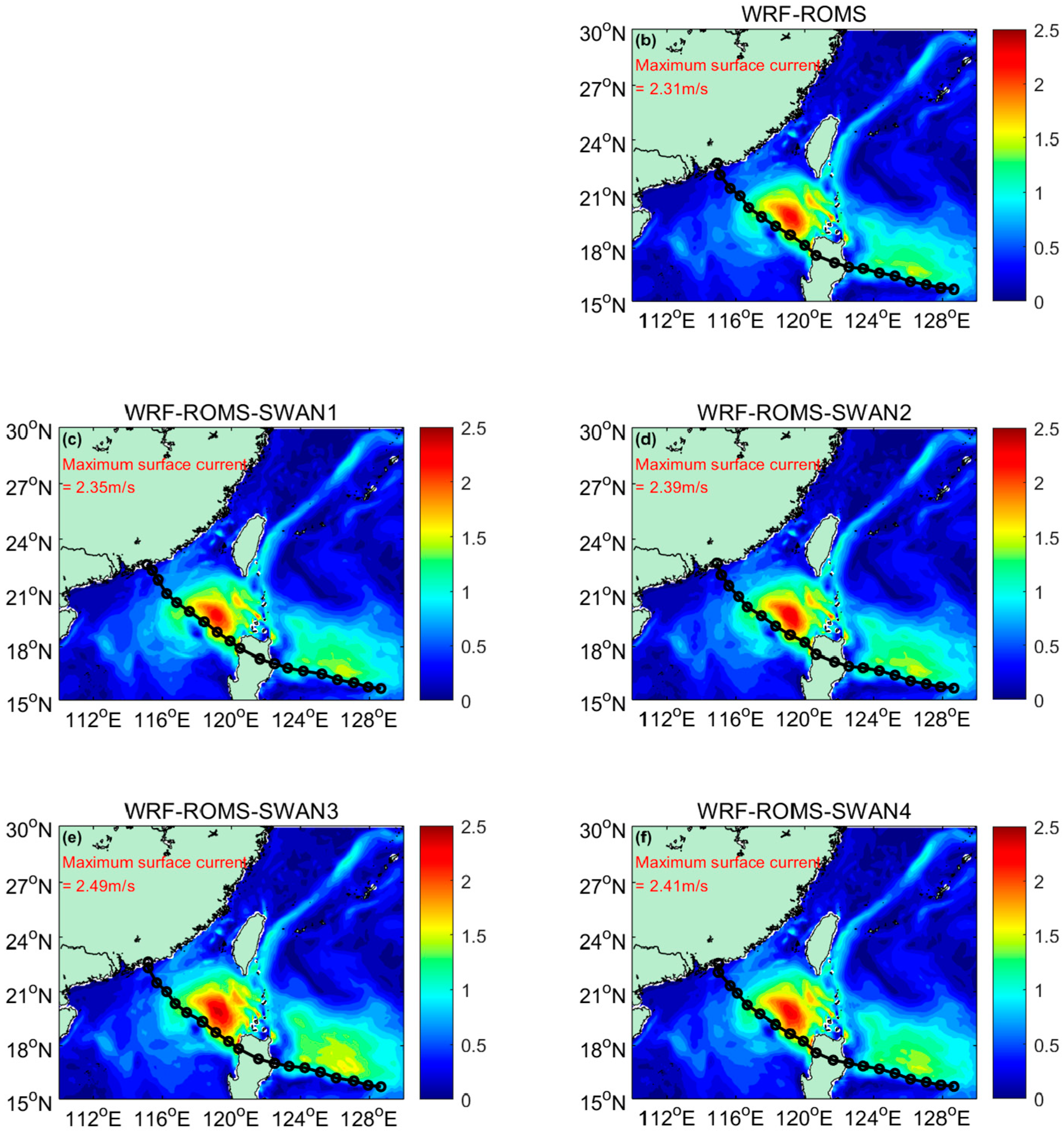
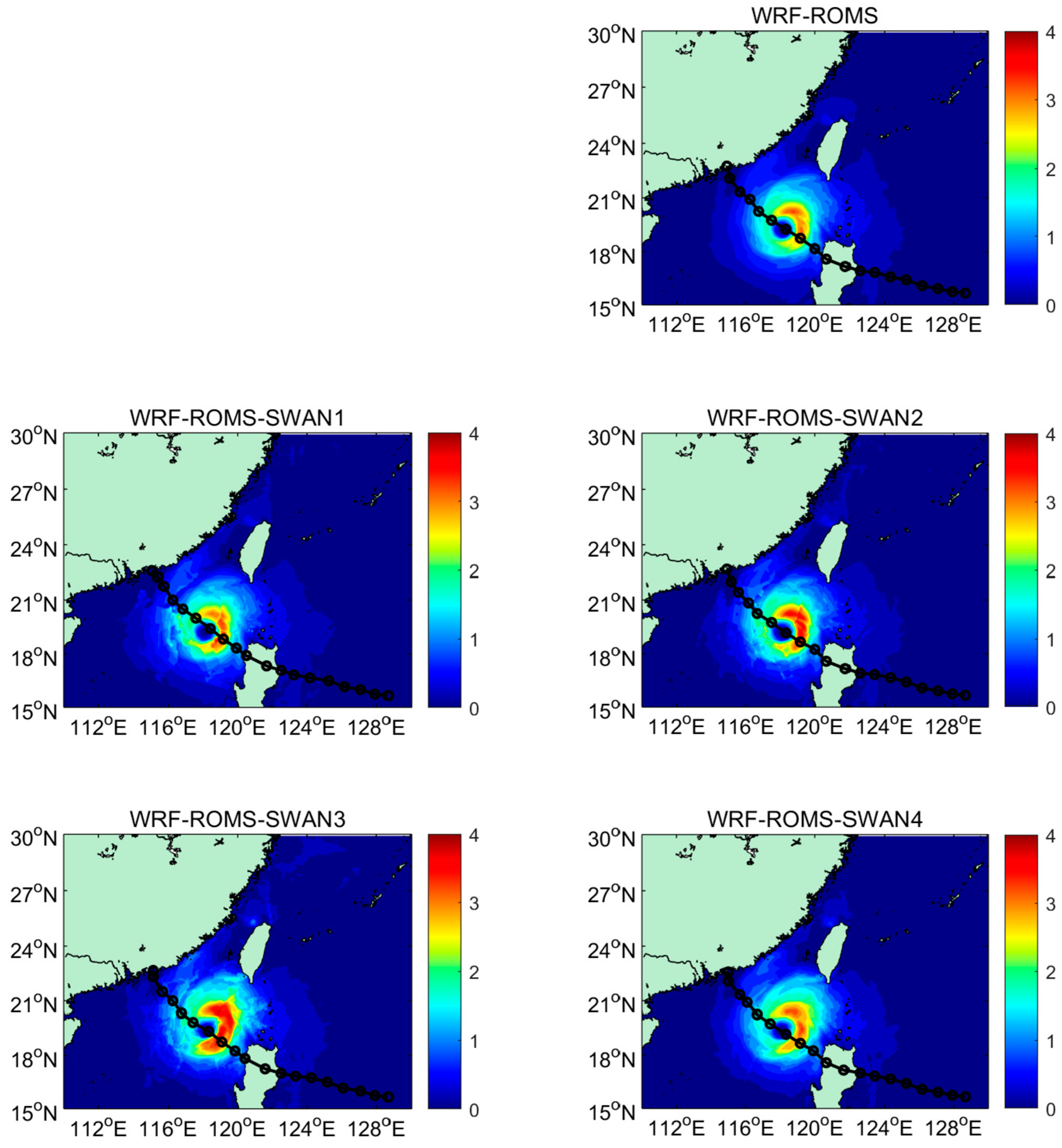
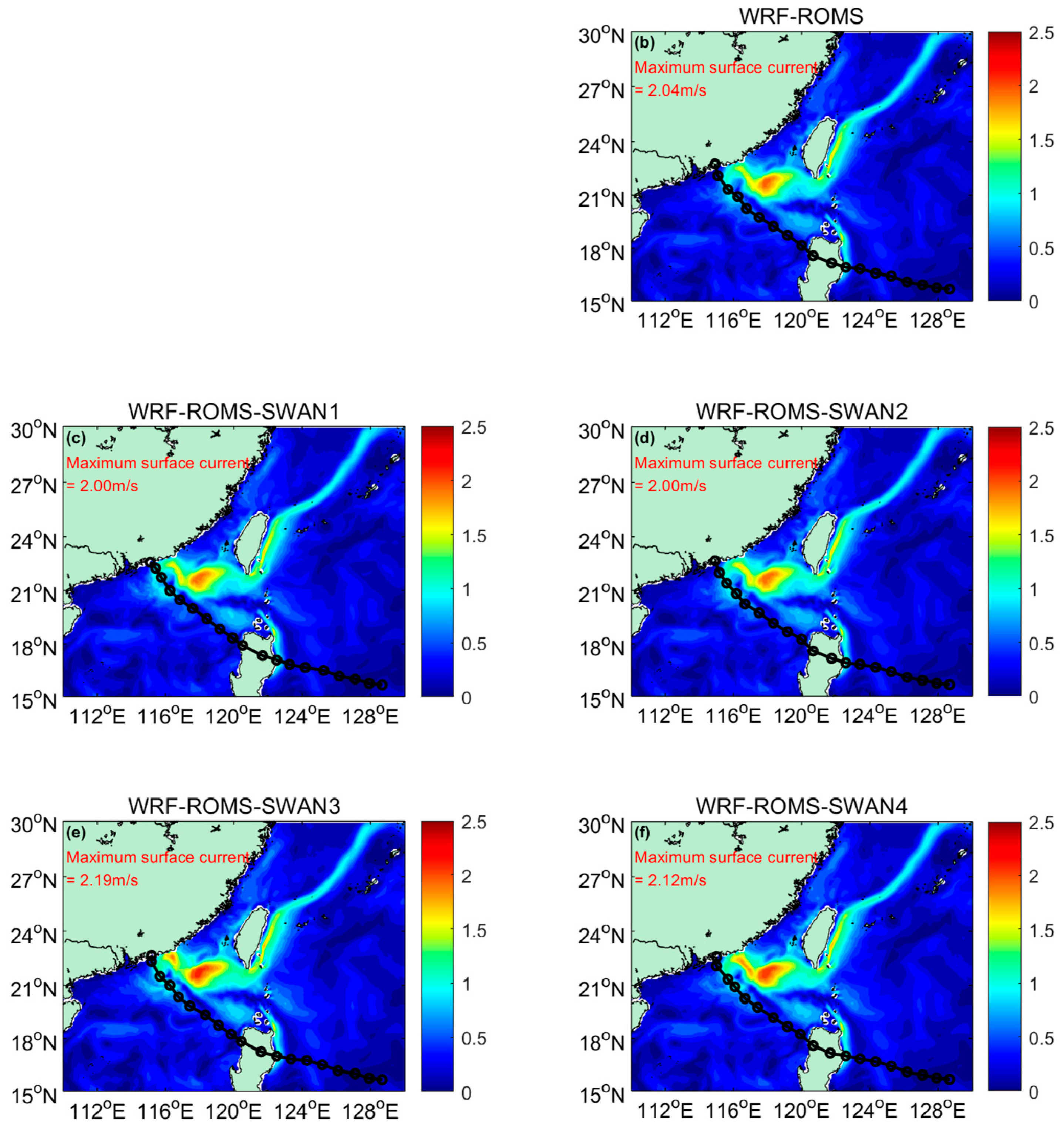
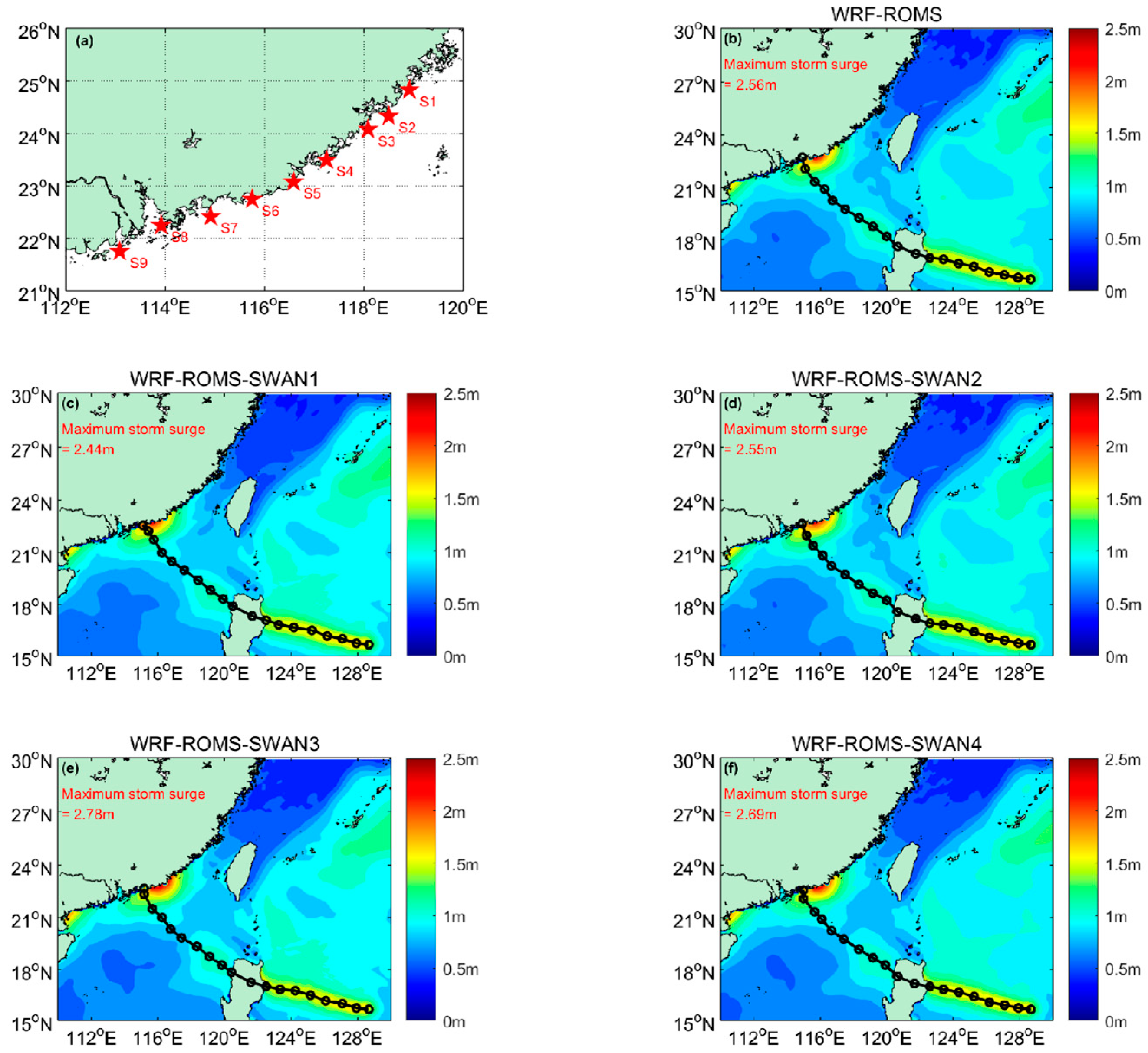
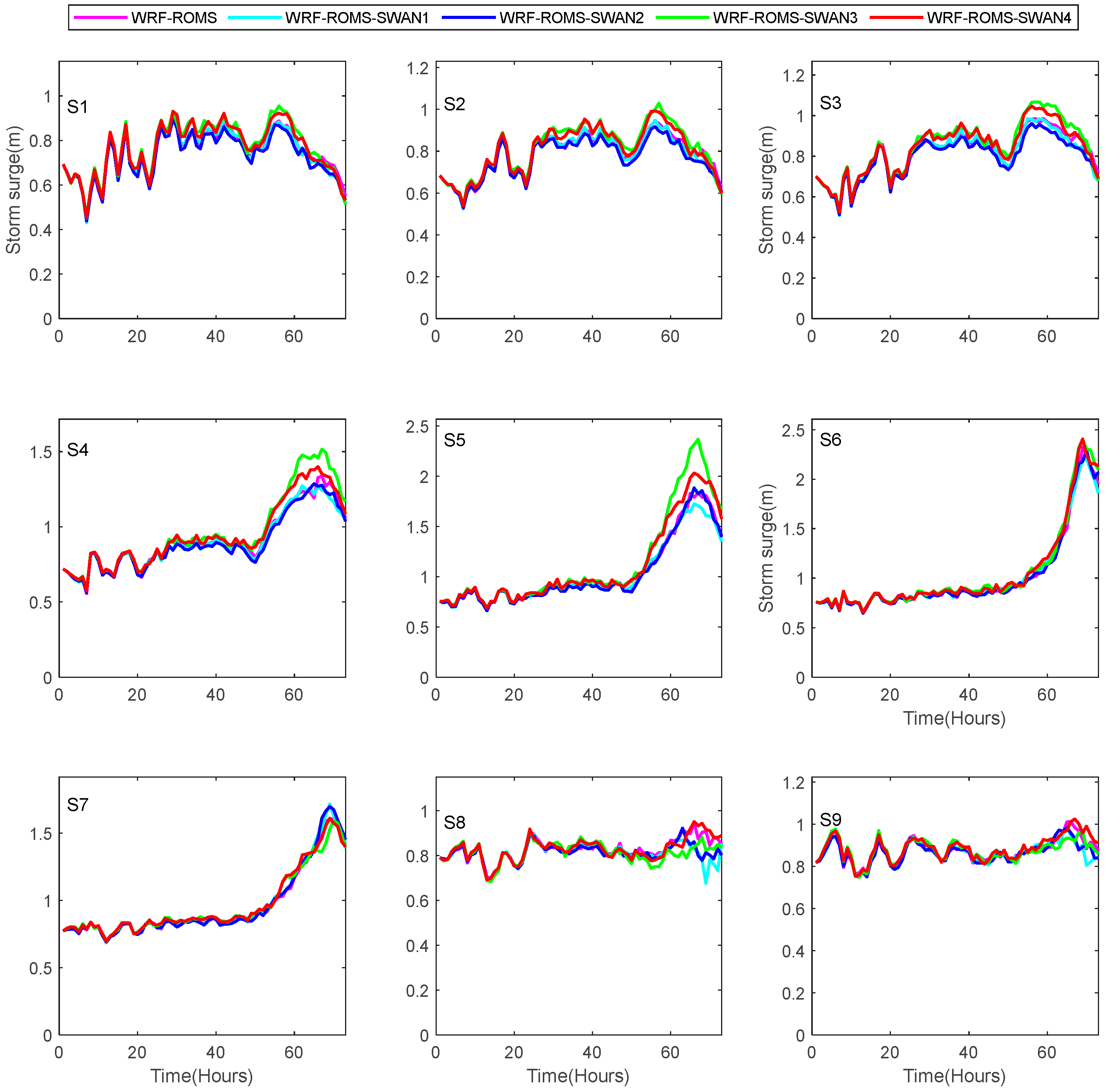

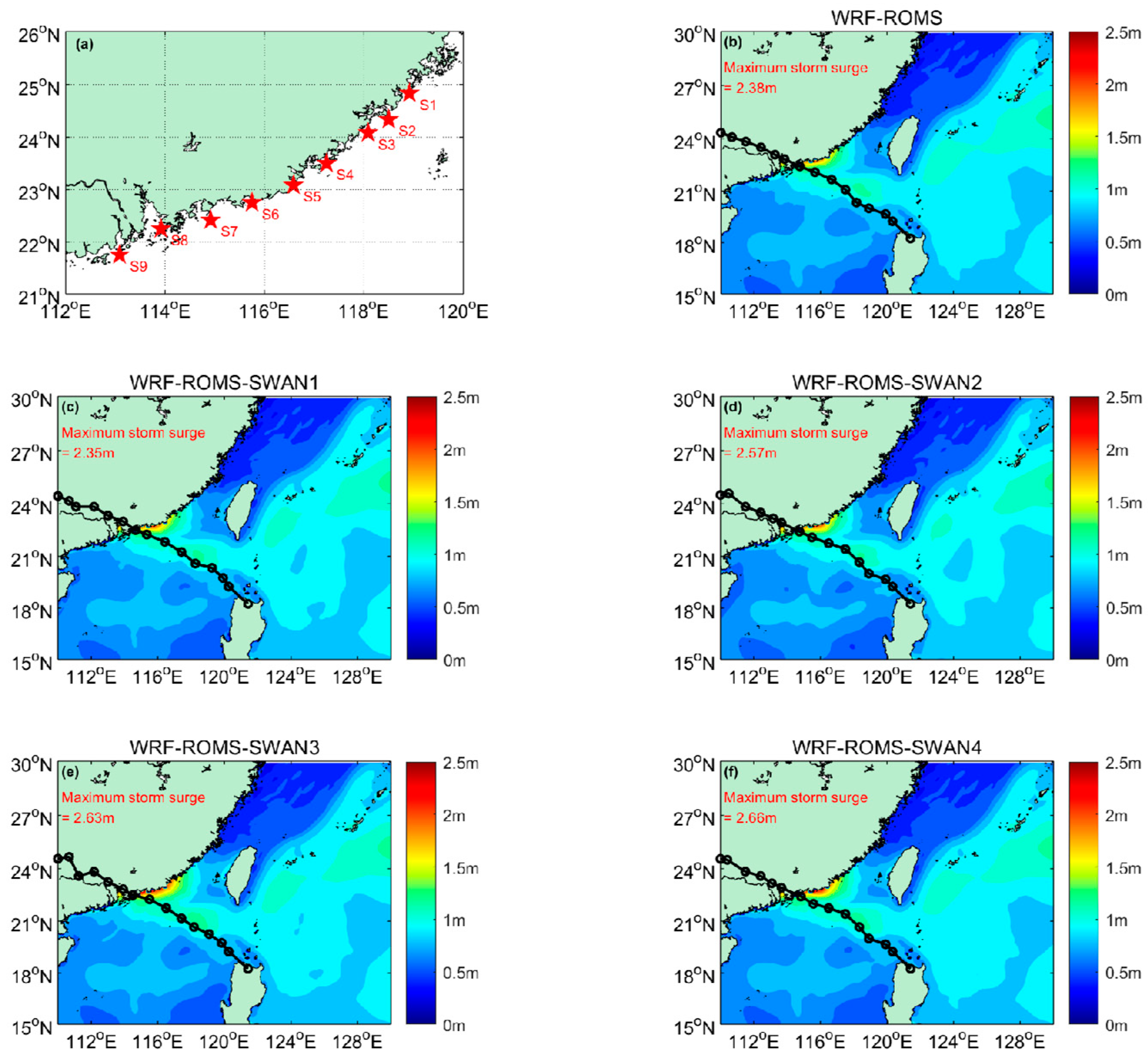

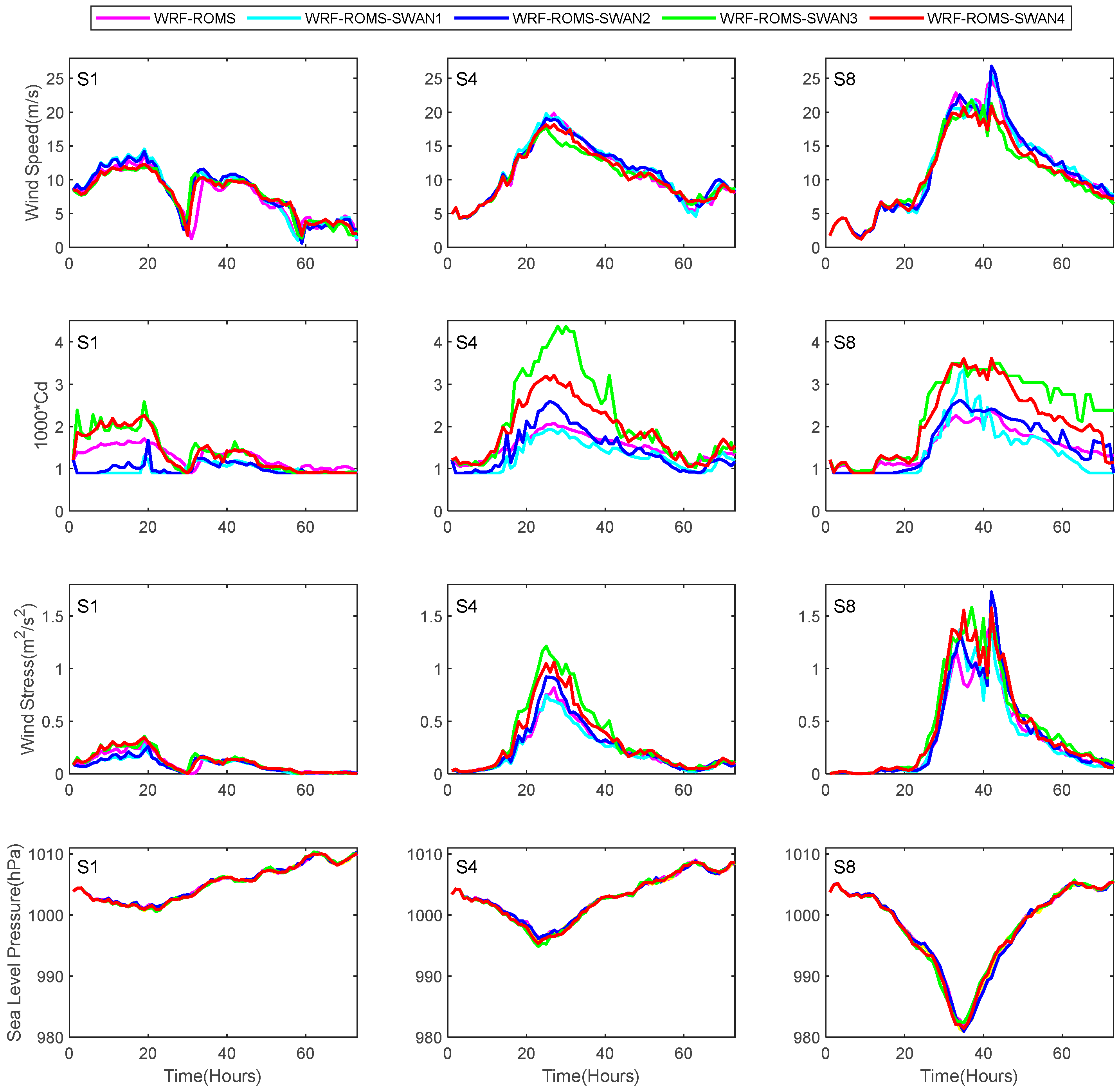
Disclaimer/Publisher’s Note: The statements, opinions and data contained in all publications are solely those of the individual author(s) and contributor(s) and not of MDPI and/or the editor(s). MDPI and/or the editor(s) disclaim responsibility for any injury to people or property resulting from any ideas, methods, instructions or products referred to in the content. |
© 2025 by the authors. Licensee MDPI, Basel, Switzerland. This article is an open access article distributed under the terms and conditions of the Creative Commons Attribution (CC BY) license (https://creativecommons.org/licenses/by/4.0/).
Share and Cite
Cai, L.; Wang, B.; Wang, W.; Feng, X. The Impact of Air–Sea Flux Parameterization Methods on Simulating Storm Surges and Ocean Surface Currents. J. Mar. Sci. Eng. 2025, 13, 541. https://doi.org/10.3390/jmse13030541
Cai L, Wang B, Wang W, Feng X. The Impact of Air–Sea Flux Parameterization Methods on Simulating Storm Surges and Ocean Surface Currents. Journal of Marine Science and Engineering. 2025; 13(3):541. https://doi.org/10.3390/jmse13030541
Chicago/Turabian StyleCai, Li, Bin Wang, Wenqian Wang, and Xingru Feng. 2025. "The Impact of Air–Sea Flux Parameterization Methods on Simulating Storm Surges and Ocean Surface Currents" Journal of Marine Science and Engineering 13, no. 3: 541. https://doi.org/10.3390/jmse13030541
APA StyleCai, L., Wang, B., Wang, W., & Feng, X. (2025). The Impact of Air–Sea Flux Parameterization Methods on Simulating Storm Surges and Ocean Surface Currents. Journal of Marine Science and Engineering, 13(3), 541. https://doi.org/10.3390/jmse13030541






